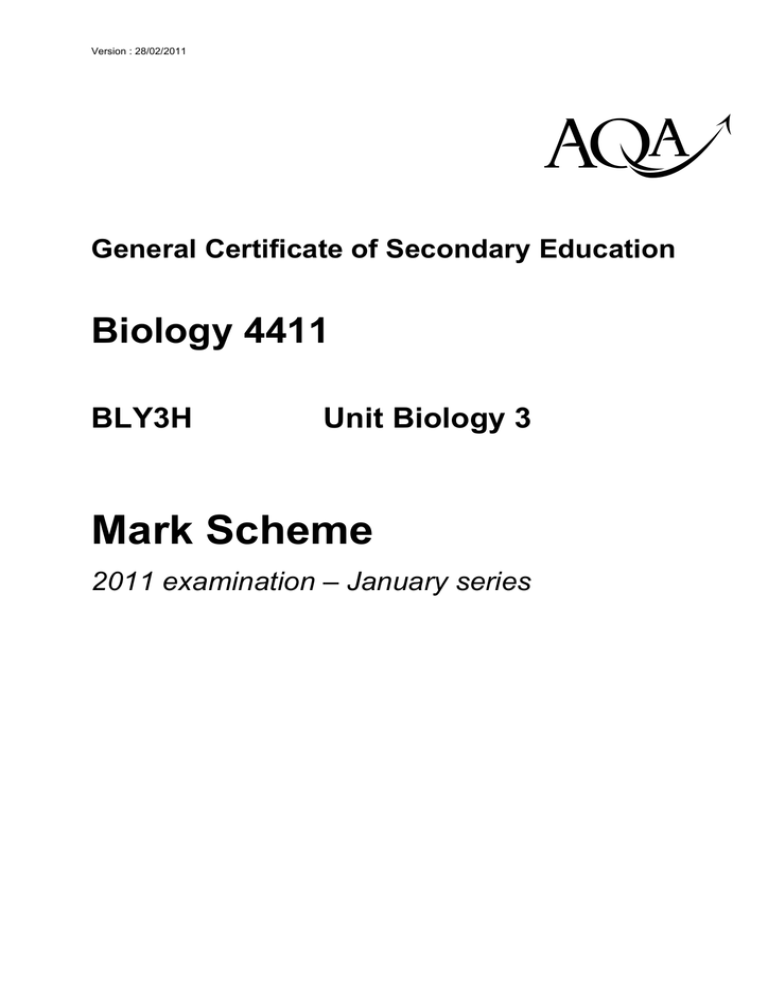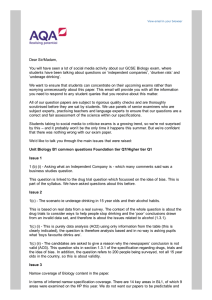
Version : 28/02/2011
klm
General Certificate of Secondary Education
Biology 4411
BLY3H
Unit Biology 3
Mark Scheme
2011 examination – January series
Mark schemes are prepared by the Principal Examiner and considered, together with the
relevant questions, by a panel of subject teachers. This mark scheme includes any
amendments made at the standardisation meeting attended by all examiners and is the scheme
which was used by them in this examination. The standardisation meeting ensures that the
mark scheme covers the candidates’ responses to questions and that every examiner
understands and applies it in the same correct way. As preparation for the standardisation
meeting each examiner analyses a number of candidates’ scripts: alternative answers not
already covered by the mark scheme are discussed at the meeting and legislated for. If, after
this meeting, examiners encounter unusual answers which have not been discussed at the
meeting they are required to refer these to the Principal Examiner.
It must be stressed that a mark scheme is a working document, in many cases further
developed and expanded on the basis of candidates’ reactions to a particular paper.
Assumptions about future mark schemes on the basis of one year’s document should be
avoided; whilst the guiding principles of assessment remain constant, details will change,
depending on the content of a particular examination paper.
Further copies of this Mark Scheme are available to download from the AQA Website: www.aqa.org.uk
Copyright © 2011 AQA and its licensors. All rights reserved.
COPYRIGHT
AQA retains the copyright on all its publications. However, registered centres for AQA are permitted to copy material
from this booklet for their own internal use, with the following important exception: AQA cannot give permission to
centres to photocopy any material that is acknowledged to a third party even for internal use within the centre.
Set and published by the Assessment and Qualifications Alliance.
The Assessment and Qualifications Alliance (AQA) is a company limited by guarantee registered in England and Wales (company number 3644723) and a registered charity (registered charity number 1073334).
Registered address: AQA, Devas Street, Manchester M15 6EX
Biology –AQA GCSE Mark Scheme 2011 January series
MARK SCHEME
Information to Examiners
1.
General
The mark scheme for each question shows:
•
•
•
•
the marks available for each part of the question
the total marks available for the question
the typical answer or answers which are expected
extra information to help the Examiner make his or her judgement and help to
delineate what is acceptable or not worthy of credit or, in discursive answers, to give
an overview of the area in which a mark or marks may be awarded.
The extra information is aligned to the appropriate answer in the left-hand part of the
mark scheme and should only be applied to that item in the mark scheme.
At the beginning of a part of a question a reminder may be given, for example:
where consequential marking needs to be considered in a calculation;
or the answer may be on the diagram or at a different place on the script.
In general the right hand side of the mark scheme is there to provide those extra details
which confuse the main part of the mark scheme yet may be helpful in ensuring that
marking is straightforward and consistent.
2.
3.
Emboldening
2.1
In a list of acceptable answers where more than one mark is available ‘any two
from’ is used, with the number of marks emboldened. Each of the following lines
is a potential mark.
2.2
A bold and is used to indicate that both parts of the answer are required to award
the mark.
2.3
Alternative answers acceptable for a mark are indicated by the use of or.
(Different terms in the mark scheme are shown by a / ; eg allow smooth / free
movement.)
Marking points
3.1
Marking of lists
This applies to questions requiring a set number of responses, but for which
candidates have provided extra responses. The general principle to be followed
in such a situation is that ‘right + wrong = wrong’.
Each error/contradiction negates each correct response. So, if the number of
error/contradictions equals or exceeds the number of marks available for the
question, no marks can be awarded.
However, responses considered to be neutral (indicated as * in example 1) are
not penalised.
3
Biology –AQA GCSE Mark Scheme 2011 January series
Example 1: What is the pH of an acidic solution? (1 mark)
Candidate
Response
1
2
3
4
4,8
green, 5
red*, 5
red*, 8
Marks
awarded
0
0
1
0
Example 2: Name two planets in the solar system. (2 marks)
Candidate
1
2
3.2
Response
Pluto, Mars, Moon
Pluto, Sun, Mars,
Moon
Marks awarded
1
0
Use of chemical symbols / formulae
If a candidate writes a chemical symbol / formula instead of a required chemical
name, full credit can be given if the symbol / formula is correct and if, in the
context of the question, such action is appropriate.
3.3
Marking procedure for calculations
Full marks can be given for a correct numerical answer, as shown in the column
‘answers’, without any working shown.
However if the answer is incorrect, mark(s) can be gained by correct
substitution / working and this is shown in the ‘extra information’ column;
3.4
Interpretation of ‘it’
Answers using the word ‘it’ should be given credit only if it is clear that the ‘it’
refers to the correct subject.
3.5
Errors carried forward
Any error in the answers to a structured question should be penalised once only.
Papers should be constructed in such a way that the number of times errors can
be carried forward are kept to a minimum. Allowances for errors carried forward
are most likely to be restricted to calculation questions and should be shown by
the abbreviation e.c.f. in the marking scheme.
3.6
Phonetic spelling
The phonetic spelling of correct scientific terminology should be credited unless
there is a possible confusion with another technical term.
3.7
Brackets
(…..) are used to indicate information which is not essential for the mark to be
awarded but is included to help the examiner identify the sense of the answer
required.
4
Biology –AQA GCSE Mark Scheme 2011 January series
BLY3H
Question 1
question
answers
extra information
mark
1(a)(i)
brain
1
1(a)(ii)
skin
1
1(a)(iii)
1/25 or 4% or 0.04 or 1 in 25
or 1:25 or 1 out of 25
1(b)
allow
1000
25000
2
any two from:
•
•
•
1
increased / high heart rate /
pulse rate
do not allow pumps more blood
unqualified
dilation / widening of arteries
/ arterioles (to skeletal
muscles)
or
less blood flow to other
organs
accept vasodilation unqualified
do not accept reference to veins /
capillaries
increased stroke volume /
described
1(c)
ignore references to breathing
more respiration / description
or
more energy required or to
provide more energy
respiration / process described →
CO2
1
do not accept anaerobic
respiration
CO2 diffuses into blood
1
1
Total
8
5
Biology –AQA GCSE Mark Scheme 2011 January series
BLY3H
Question 2
question
answers
2(a)
to kill (other) (micro) organisms
(in the milk) / to sterilise
extra information
allow germs
mark
1
ignore viruses
allow destroy
ignore pasteurise
2(b)(i)
0.015
award 2 marks for correct
answer irrespective of working
2
allow answer or use of 1.5 for 1
mark
allow 1 mark for
( y1 − y 2 )
but incorrect answer
100
y-values may be incorrect
or
use of 6.0 and 4.5 but incorrect
answer
2(b)(ii)
2(c)
running out of substrate / sugar
/ food
or
(acid / low pH) denatures
enzymes / proteins / kills
bacteria
1
accept stops / slows enzymes /
metabolism
allow (acid / low pH) stops /
slows bacteria working /
growing
lactic
acid
2(d)(i)
25
2(d)(ii)
pathogens / harmful bacteria
(might) grow (at 35 °C)
1
if incorrect acid allow 1 mark
1
1
do not accept viruses
Total
1
8
6
Biology –AQA GCSE Mark Scheme 2011 January series
BLY3H
Question 3
question
3(a)
answers
extra information
mark
large surface / large area
1
thin / short distance (from air to
blood) / one cell thick / two cells
thick
1
good blood supply / many
capillaries / capillary network /
many blood vessels
1
ignore moist surface
3(b)(i)
diffusion
ignore gaseous exchange
1
3(b)(ii)
brings (more) oxygen / air into the
lungs / alveoli
1
keeps O2 level high in alveoli
1
or
maintains concentration
difference (between alveoli and
blood) / keeps O2 concentration in
alveoli > O2 concentration in blood
gains 2 marks
Total
6
7
Biology –AQA GCSE Mark Scheme 2011 January series
BLY3H
Question 4
question
answers
extra information
mark
4(a)(i)
carbohydrase
allow correct named example
eg amylase / maltase
1
4(a)(ii)
fermentation / anaerobic
respiration
accept alcoholic fermentation
1
4(b)
any three from:
3
•
ethanol renewable / can be
re-made
or
petrol non-renewable / can’t
be re-made
•
maize / plants /
photosynthesis takes in CO2
•
(ethanol) causes less
increase / no increase in CO2
concentration in the
atmosphere or (ethanol) is
carbon neutral
accept converse for petrol
ignore ethanol gives off less CO2
•
(ethanol) has less effect / no
effect on climate / on global
warming
accept converse for petrol
accept correct reference to
named pollutant / effect from
petrol
Total
5
8
Biology –AQA GCSE Mark Scheme 2011 January series
BLY3H
Question 5
question
answers
5
active transport needs energy or
diffusion is not energy-dependent
1
any three from:
3
•
(energy from) aerobic
respiration
•
more respiration with O2 or
more energy release with O2
•
(aerobic) respiration / energy
release occurs in
mitochondria
•
xylose / other sugars
absorbed by diffusion / not by
active transport
extra information
mark
do not allow anaerobic
allow active transport is selective /
specific
or active transport can distinguish
glucose and xylose
Total
4
9
Biology –AQA GCSE Mark Scheme 2011 January series
BLY3H
Question 6
question
6(a)
6(b)
answers
extra information
mark
maintain / constant / suitable /
optimum temperature or to
prevent overheating
ignore to cool (= question)
1
high temperature denatures
enzymes / proteins / high
temperature kills microorganisms
/ fungus
do not allow death of enzymes /
denatures microorganisms
1
microorganisms / fungus /
respiration release energy
allow release heat
1
any four from:
•
very little / no measurable
fungus / biomass before 20 h
•
need fungus present to make
protease enzyme or protease
is a product from the fungus
or protease not made until the
fungus is made
•
protease not made until
glucose is used
•
glucose needed for energy /
respiration or glucose as
material for growth / to make
more fungus
•
equipment not sensitive
enough to measure low
concentrations
4
allow spores take about 20 h to
start growth
allow protease increases as
glucose decreases
Question 6 continues on the next page
10
Biology –AQA GCSE Mark Scheme 2011 January series
BLY3H
Question 6 continued
question
6(c)
answers
extra information
mark
40 (no mark)
2
any two from:
•
(40) gives the highest yield /
activity of enzyme per g
glucose
•
(40) gives highest yield /
activity of enzyme per g
fungus produced.
•
(40) is more economic / saves
money
if neither point made allow 1 mark
for (40) gives the highest yield /
activity of enzyme
Total
9
11
Biology –AQA GCSE Mark Scheme 2011 January series
BLY3H
Question 7
question
answers
extra information
mark
7(a)(i)
A
1
7(a)(ii)
(protein molecule is) too large to
pass through the filter / cannot
pass through the filter
1
7(b)
RBC is too big to / cannot pass
through filter
1
haemoglobin released when RBC
bursts
or
haemoglobin inside RBC in a
healthy person
1
haemoglobin is small enough to /
can pass through filter
or
haemoglobin diameter < pore
diameter
or
haemoglobin only 5.5 nanometres
1
Total
5
12

